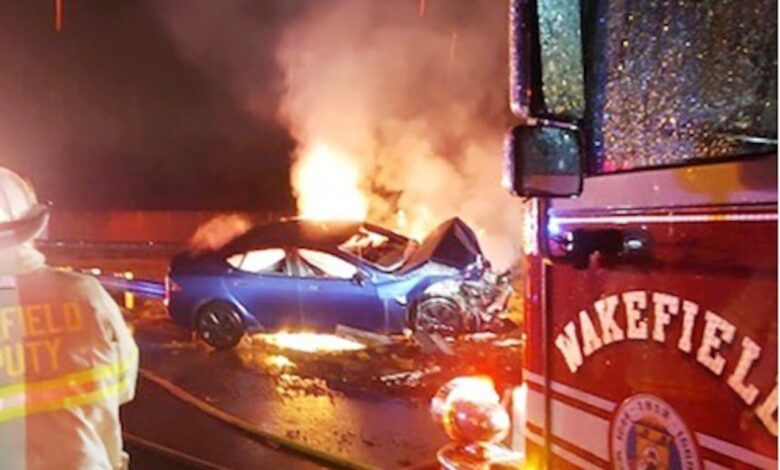Electric vehicle fires rare, but too hot to fight

SPRINGFIELD — Fires in electric vehicles — EVs for short — are rare, with the most recent one in Springfield occurring over the winter, said city fire spokesman Capt. Drew E. Piemonte.
State statistics show an average of just 14 EV fires a year in Massachusetts, versus about 2,300 vehicle fires overall in a year.
But with EVs more common, the state is ramping up training, and local fire departments are investing in safety plugs and fire-resistant smothering blankets to keep firefighters, the public and people’s property safe. The East Longmeadow Fire Department is even setting up recycling points, where people can turn in the smaller lithium-ion batteries common today in tools and outdoor gear.
Earlier this week, the state fire marshal said fires with all types of lithium-ion batteries are more common than previously thought. New recordkeeping found 50 incidents where the batteries played a role in sparking the fire, more than double the annual average detected by a national system, the Department of Fire Services announced Wednesday morning.
There have always been battery fires, said Deputy Fire Chief Kevin Galligan of the Brockton Fire Department. But lithium-ion batteries are more powerful than the older technology.
“Everybody wants their drill to work the whole day on one charge,” he said. “Everyone wants their leaf blower to do the whole yard,” said Galligan, who traveled to New York City last year to learn the city Fire Department’s tactics and taught a seminar for Massachusetts firefighters back in October. “We are seeing them everywhere.”
Lithium-ion batteries, including those in vehicles, are packed with energy and can, when damaged, go into a chain reaction called thermal runaway, making an EV fire vastly different and more dangerous to fight than a traditional car fire, said Jake Wark, a spokesman for the state fire marshal.
And EV fires are hotter, 5,000 degrees Fahrenheit, while a gasoline-powered vehicle on fire burns at 1,500 degrees. It takes about 2,000 gallons of water to extinguish a burning gasoline-powered vehicle; putting out an EV fire can take 10 times more, according to Clemson University.
“We go in a defensive mode with those fires,” Piemonte said.
A burning Tesla in Wakefield last year took 20,000 gallons of water to put out.
“It takes a tremendous amount of water,” said John Dearborn, fire chief in Longmeadow.
Which is a problem in places, like Interstate 91, where there are no hydrants. Foam can also cool and slow an EV fire, but it’s not a sure thing.
Longmeadow bought a plug that de-energizes electric vehicles when put in the charging port.
It’s impossible to tell if an eclectic vehicle is still on, even its on fire. Most don’t need keys, just the presence of a fob or even an owner’s cellphone.
Galligan said the plug works by fooling the car into thinking it’s being charged, thus shutting down.
East Longmeadow spent a $1,300 state grant in February on an insulating and flame-resistant blanket for dealing with car fires, said Deputy Fire Chief Chris Beecher.
“It gives us a chance to protect the exposures around it,” he said. “It doesn’t extinguish the fire. As soon as we take the blanket off, we know it can reignite.”
Easthampton has a similar blanket, he said.
Galligan said EVs can reignite even days later. His city, Brockton, requires tow truck operators to keep EVs wrapped as they remove them from wrecks and to store them wrapped or well away from other cars or buildings.
“A car can reignite on the way to the tow yard,” he said.
The batteries also are stored in weatherproof housings to keep them dry, making it hard to get water on them.
Generally, when it’s time to dispose of them, too many people are simply throwing them in the trash where they can get punctured and start a fire, officials said.
East Longmeadow’s Beecher noted that hardware stores do take them back for proper disposal.



